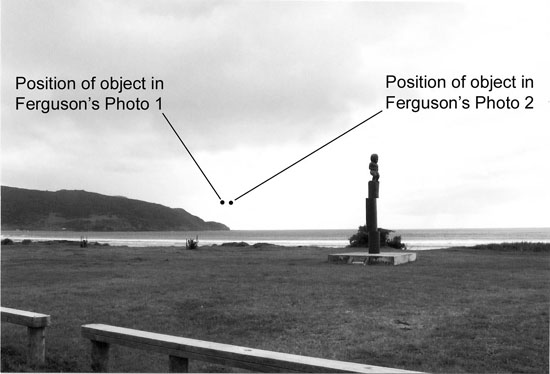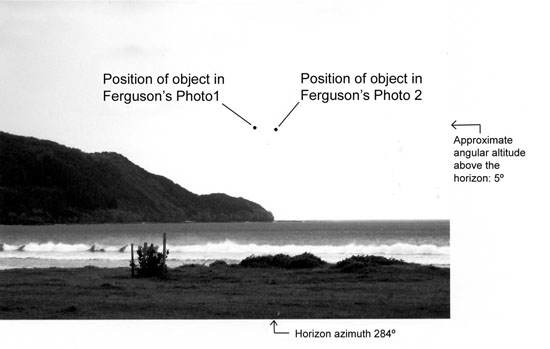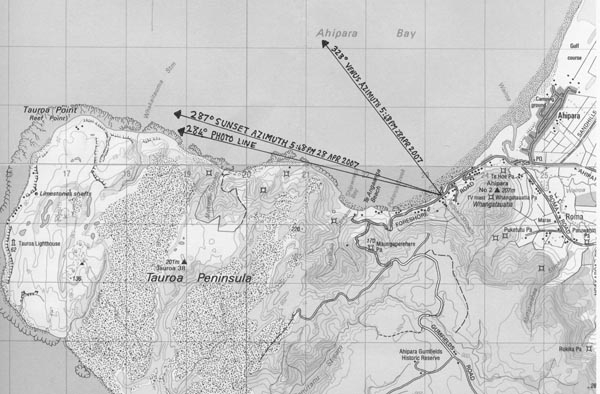Photos of a bright, slow-moving object over Northland caused quite a stir when they were published in the local newspaper last year, but some patient detective work has revealed the likely identity of this UFO.
Around sunset on 28 April 2007 Mr Wayne Ferguson took eight photos from Ahipara Beach, near Kaitaia, of an anomalous illuminated object in the western sky near the horizon. He used a Sony DSCF828 compact digital camera and took the photos over a time interval of about three minutes. He reported perceiving the object to be moving very slowly in a northerly direction to his right, and away from him, during the few minutes that elapsed while he was photographing it.
Some time later Mr Ferguson gave the photos, in electronic form, to UFOCUS NZ who published them on their website in August with a summary of Ferguson’s report of the circumstances, other witness reports, and an excerpt from an assessment of the photos by the well-known American UFO analyst Dr Bruce Maccabee.
Suzanne Hansen, of UFOCUS NZ, contacted the Northern News seeking publicity for this event, which she classified as an “unusual aerial phenomenon” (UAP). The newspaper published two of Wayne Ferguson’s photos with a front-page story on 29 August 2007. This triggered much public interest in the form of further witness reports and further coverage by the Northern News.
Of the eight Ferguson photos published on the UFOCUS website (www.ufocusnz.org.nz/ahipara.html) six were close-ups of the sky object with no ground references. The other two photos included ground features-a headland and sea horizon. These ground references allowed the possibility of geometrical analysis. The planet Venus was present in the northwest evening sky at the time of Ferguson’s photos, and aircraft vapour trails was another possible explanation. Establishing the photo geometry could well be a useful avenue for investigating these possibilities, so I determined to do some on-site measurements. The report posted on the UFOCUS website said that Air Traffic Control had confirmed there were no scheduled flights in the area at the time. I thought it worthwhile to verify this independently in the interests of thoroughness.
Measurements

I visited Ahipara Beach on 6 September 2007 between noon and 4pm. I had not been able to communicate personally with Wayne Ferguson, but I had read the UFOCUS website report and taken my own prints of the photos from the website.
I located Mr Ferguson’s camera position by looking for the viewing angle of the westward headland that revealed the exact headland profile as in Ferguson’s photos. Using my own camera I took replicating photos of the same sight line at a variety of zoom settings (Figure 1, 2).
From this location I then took a compass bearing to the north end of the headland where it met the reef. Applying the appropriate magnetic-grid-true adjustments I plotted this bearing on the topographical map with a protractor and it yielded a true bearing (horizon azimuth) of 284°. The distance from the camera location to the end of the headland derived from the map scale was 2.25 kilometres. I derived the latitude and longitude of the camera location from the map grid coordinates using a coordinate conversion tool. The ephemeris sunset azimuth for that date, viewed from that location, was 287°, and sunset time 5.49 pm NZST (rounded values).

I then estimated the angular altitude above the sea horizon of the anomalous sky object in Ferguson’s photos by reference to the object’s proportionate spatial relationship to the headland in the photos, but taking the measurement by sighting to the actual headland. It was necessarily an estimate because the object was, of course, not there in the sky when I was taking the measurement. (It would have been methodologically improper to take this measurement within Ferguson’s photo because of the unknown telephoto factor). I estimated the altitude of the object to be about five degrees. My measurement technique for this was cruder than that for my azimuth measurement. I didn’t have a navigator’s sextant or other precise altitude instrument, and there was no sky object to fix it on anyway, so I made do with the backyard astronomer’s favourite way of roughly measuring sky angles by sighting finger widths at arms length-previously calibrated with a clinometer and by reference to well-known star separations. The potential error of this method would be less than five degrees, which I deemed not critical for this measurement. Because the angular separation of the object from the headland and horizon was so small I also ignored the small errors inherent around the edges of the photos from the focal-plane distortion of scale caused by camera lenses.

Using the measured azimuth of the end of the headland I then estimated that the azimuth of the sky object was 283° in one of the headland photos, and 284° in the other headland photo, by reference to its obvious different azimuthal alignment with the headland in the two photos (Figure 2). In other words, the sky object in Ferguson’s photos had apparently moved about one degree of azimuth northward in the short time that elapsed between the two photos. If the camera location was the same for the two photos this change could only be real motion of the object itself. If the camera location was different for the two photos the change could be accounted for by parallax shift (apparent motion) due to the change in the observing position, and not real motion of the object. At the measured distance between the camera and the headland (2.25 kilometres) an apparent motion of about this magnitude due to parallax shift would result if the camera were moved as little as 50 metres laterally right (Figure 3). So far, my efforts to contact Mr Ferguson for clarification have failed. Meantime I assume that he did not move his camera position significantly and the object itself moved about one degree of azimuth northward in less than three minutes. This is consistent with Ferguson’s own description of his observation reported on the UFOCUS website.
Although the six close-up photos had time tags logged by the camera clock, unfortunately the two photos containing the headland did not. I assumed that the two photos containing the headland were taken within the same time window as the close-ups, but I have no way of verifying this at present.
It was not Venus
At the time of Ferguson’s photos the planet Venus was at magnitude -4.1, and approaching its maximum brightness. At this magnitude it is visible in broad daylight in the middle of a sunny day and becomes a conspicuous object in the western sky a few minutes after sunset. No other astronomical body except the Sun and Moon matches the brilliance of Venus when it is at this magnitude. It becomes this bright about every 19 months and maintains it for many weeks. This is why it frequently triggers UFO reports by people unfamiliar with the behaviour and motions of planets and stars, and this is why I investigated it in this case. Venus would have been visible in the northwest quadrant of the sky when Ferguson took his photos. However, my measurements of the photo geometry conclusively ruled out Venus. The azimuth of Venus from Ferguson’s camera position at the time was 323°. The camera line of sight was around 284° azimuth. So, on the telephoto zoom setting used, Venus would have been more than 30° outside the camera field of view northward. This is corroborated by the altitude geometry-the altitude of Venus above the horizon was 19° and the estimated altitude of the anomalous object in the photos was about 5°.
Was it vapour trails?
The next likely explanation was a vapour trail of a high-flying jet aircraft. In some of the sharper of Ferguson’s photos the object seems to be divided into two elongated parts with slight curvature. It was no doubt this feature that led American UFO investigator Dr Bruce Maccabee to suggest, as quoted on the UFOCUS website, that the object might be “a jet contrail viewed end on.” The website noted, “However ATC has confirmed that there were no scheduled flights in that area at that time.” Further scrutiny of the photography and checks on air traffic records were called for.
Photography analysed
The clock in Wayne Ferguson’s camera indicated that his photos were taken around sunset. However, the camera clock gives certainty only for the time interval over which the photos were taken, not for the actual time of each photo, unless the clock error at the time of photography is known. If the clock error is known it can be added to, or deducted from the clock reading to determine the actual time of the photo. In this case the clock error would have to be more than five minutes fast or slow to have a critical effect on the analysis. Since I was not able to ascertain Ferguson’s camera clock error I assumed the camera clock was reading within plus or minus five minutes of the correct time. Greater precision than this is no advantage in this case because, although sunset time for a particular location can be calculated to an accuracy of seconds, the actual time when the Sun is seen to disappear below the horizon can differ from the calculated time by up to two minutes due to the refraction of the atmosphere at the horizon on the day. Camera autofocus systems do not handle difficult light conditions well. The classic problem situation is where there is a bright light source in the middle of poorly lit surroundings. In these situations the autofocus system is likely to misread the distance to the object and it will be blurred. The use of manual focus mode is essential in these situations.
Digital zoom tools hugely increase the telephoto effect of the optical zoom capabilities of the lens to the extent that camera shake has a blurring effect on the image. It is essential to use a tripod, or steady the camera on something rigid, when using the digital zoom tool on a digital camera.
Since I don’t know the specifics of Ferguson’s camera settings I have to make some assumptions based on the nature of the images. His six close-up photos have obviously been taken on a high telephoto setting given the tiny relative size of the object in the other two photos. It is possible the images were cropped and enlarged further in computer photo-editing software. His camera features a ‘Smart Zoom’ tool in addition to the optical and digital zoom tools. This feature can extend the telephoto zoom effect to 36×, but only at the lowest resolution. Such a large telephoto effect will considerably reduce the image definition, especially if the image was further cropped and enlarged in photo-editing software. At the maximum telephoto setting on this camera these definition defects would be compounded further by camera shake if the camera was not steadied on a tripod. These considerations dictate caution in reading too much into the detail of the illuminated sky object in the images.
If you use your imagination you can see in Ferguson’s close-up images the hint of an oval hat-shaped object. The most blurred image of the six especially gives this impression. (Notably it was this image that UFOCUS supplied to the Northern News.) In my opinion this is an illusion caused by a random trick of the light combined with the poor definition of the image. This is a similar kind of illusion to the so-called “ambiguity” illusions, such as the well-known outline of a duck’s head that can also be perceived as a rabbit’s head. All eight of Ferguson’s photos were quite low resolution, which fosters the illusion. Although we could not rule out the possibility that the object was a hat-shaped moving craft of unknown origin and technology, it was more likely something quite ordinary. Such an ordinary explanation presents itself quite conspicuously in this case.
Flight EK 433 was there
I browsed the commercial airline flight schedules and found that Emirates Flight EK 433 leaves Auckland for Brisbane every day, all year round. Its scheduled departure time is 4.55 pm. I requested the air traffic record for this flight from Airways Corporation of New Zealand. Mr Ken Mitchell replied:
“I can confirm that EK 433 departed Auckland at 5.12 pm NZST on 28 April 2007, and would have been approximately 75 nautical miles west of Kaitaia at 34,000 ft at 5.45 pm.” (Personal communication dated 25 September 2007).
At this altitude and distance the aircraft would have been still in sunlight at the time. If it generated vapour trails the light of the setting sun would have lit up the trails brilliantly. But, at a distance of 75 nautical miles (139 kilometres), the aircraft itself would not have been easily visible.
A simple trigonometric calculation shows that an object 139 kilometres away at an altitude of 34,000 feet (10,370 metres) would be seen at 4.27° above the horizon by an observer at sea level. This figure is impressively within the margin of error of my estimate of the angular altitude above the horizon of the illuminated sky object in Ferguson’s photos. The direction is also consistent with Ferguson’s camera line of sight.
The rate of movement of the object reported by Wayne Ferguson during the three or four minutes he observed it was consistent with my own finding that the object moved about one degree of azimuth in the short time between the two headland photos. This apparent rate of movement is consistent with an ordinary commercial jet aircraft flying at cruising speed at 34,000 feet, 139 kilometres away, on a course obliquely away from an observer. Such aircraft commonly generate vapour trails that disappear at the trailing end as they are formed at the leading end, giving the impression that the trails are following the aircraft in unison with its motion. This explanation fits the photographic, geometric and eyewitness evidence very well.
If the object in Ferguson’s photos was not Flight EK 433 but some other unidentified craft, it seems a remarkable coincidence that the unidentified craft was on a similar course at a similar time travelling at a similar speed as Flight EK 433. We could invent far-fetched scenarios to support this possibility (perhaps the unidentified craft was shadowing EK 433?). But we are dealing with probabilities here. Which is the more likely scenario? The far-fetched one or the ordinary one? The complicated one or the simple one? The scientific approach is to accept the more probable explanation-the ordinary simple explanation-until proved otherwise. In the absence of hard evidence to the contrary, the simple explanation is preferable in terms of the principle of parsimony-also known as Occam’s razor. This well-known principle in science states that one should not introduce more hypotheses than are necessary to explain the data.
What would constitute hard evidence of the extraordinary explanation in a case like this? It would need to be more than a collection of distant photos of a blurred point of light. Extraordinary claims demand extraordinarily good evidence.
Even if the remaining uncertainties constrained us to continue holding this case in the ‘unidentified’ category, this would not necessarily mean it was something extraordinary. The absence of a fully proven explanation does not mean the case totally defies explanation. It just means we don’t have enough information to clinch it.
